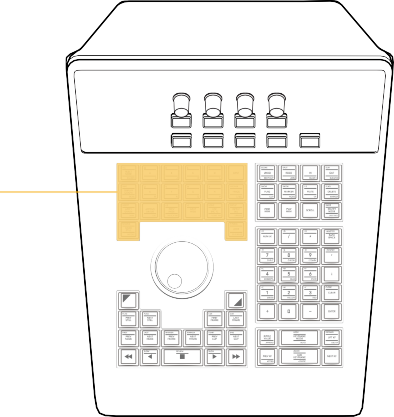
< Previous | Contents | Next >
The Search Dial panel, typically located on the right for a right-handed colorist, has an LCD display with four variable controls and nine soft keys. The lower section of the panel houses the Jog/Shuttle knob and six groups of hard keys. Each group and their keys are described below.
Memories Group
The first group of keys is the Memories group. These include the grade reset controls, buttons for storing and recalling memories (by letter), and controls for grabbing and browsing stills, applying grades, and controlling looping for playback.

The letter keys in this group are called “memories” or MEMs, which save stills and grades that you can quickly apply to another clip to overwrite its previous grade. There are 26 MEMs, labeled with letters from A to Z. To apply a MEM to another clip, simply press the letter corresponding to the MEM with the grade you want to apply. To save a grade to a MEM, press CRNT and then the letter of the MEM you want to save to. More information appears in the table of key functionality below.
Memories Keys
![]()
The Memories keys let you save and recall memories for quick grade propagation, grade reset buttons, and other grade management functions.
Key | Shift Up | Primary Function | Shift Down |
ALL/RESET NODE/GRADES
| (ALL) Reset All Grades and Nodes; resets the entire grade of the current clip back to the default of one unadjusted node | (RESET NODE) Reset Selected Node Grade; resets all adjustments that have been made to the currently selected node | (GRADES) Reset Grades and Keep Nodes; resets each node of the current clip’s grade but keeps the node structure intact |
Key | Shift Up | Primary Function | Shift Down |
Q/A/I
| (Q) Loads or saves memory Q | (A) Loads or saves memory A | (I) Loads or saves memory I |
R/B/J
| (R) Loads or saves memory R | (B) Loads or saves memory B | ( J) Loads or saves memory J |
S/C/K
| (S) Loads or saves memory S | (C) Loads or saves memory C | (K) Loads or saves memory K |
T/D/L
| (T) Loads or saves memory T | (D) Loads or saves memory D | (L) Loads or saves memory L |
CRNT
| – | (CRNT) Press CRNT and then any letter key to save the image and grade at the current frame to that memory for recall | – |
INFO/DISPLAY GRAPH/MEMS
| (INFO) Toggles the Still Properties window open and closed; the Still Properties window shows information about the currently selected still in the Gallery | (DISPLAY GRAPH) Displays the node graph of the selected still in the Gallery (only while the Gallery is open) or hides a displayed node graph | (MEMS) Toggles open and closed the memories section of the Gallery |
U/E/M
| (U) Loads or saves memory U | (E) Loads or saves memory E | (M) Loads or saves memory M |
V/F/N
| (V) Loads or saves memory V | (F) Loads or saves memory F | (N) Loads or saves memory N |
![]()
Key Shift Up Primary Function Shift Down
W/G/O (W) Load or save
memory W
(G) Loads or saves memory G
(O) Loads or saves memory O
X/H/P (X) Loads or saves
memory X
(H) Loads or saves memory H
(P) Loads or saves memory P
+POWER/+PAGE/LABEL (+POWER) Adds
another Power Grade album to the Gallery
(+PAGE) Adds another project album to the Gallery
(LABEL) Selects the name of the currently selected album of the Gallery so you can change it
INSERT/APPLY GRADE/LABEL (INSERT) Not yet
implemented at the time of this writing
(APPLY GRADE)
Applies the grade of the selected still in the Gallery to overwrite the grade of the current clip
(LABEL) Selects the label of the selected still in the Gallery so you can add one or change it
APPEND GRADE/DEL – (APPEND GRADE)
Appends all nodes from the grade of the selected still in the Gallery after the last node of the grade of the current clip
(DEL) Deletes the selected still in the Gallery
-2/PREV PAGE/MATCH FM (–2) Copies grade
from two clips before the current clip to overwrite the grade in the current clip
-1/NEXT PAGE (–1) Copies grade from the clip just before the current clip to overwrite the grade in the current clip
NONE/USE SRC TC/START FM (NONE) Changes the
“Apply Grades Using” option in the Gallery to No Keyframes
(PREV PAGE) Selects the previous Album in the Album list of the Gallery
(NEXT PAGE)
Selects the next Album in the Album list of the Gallery
(USE SRC TC) Changes the “Apply Grades Using” option
in the Gallery to Keyframes Aligning Source Timecode
(MATCH FM) Performs a Match Frame operation that moves the playhead to the frame of the Timeline that matches the currently selected still in the Gallery
![]()
–
(START FM) Changes the “Apply Grades Using” option in the Gallery to Keyframes Aligning Start Frames
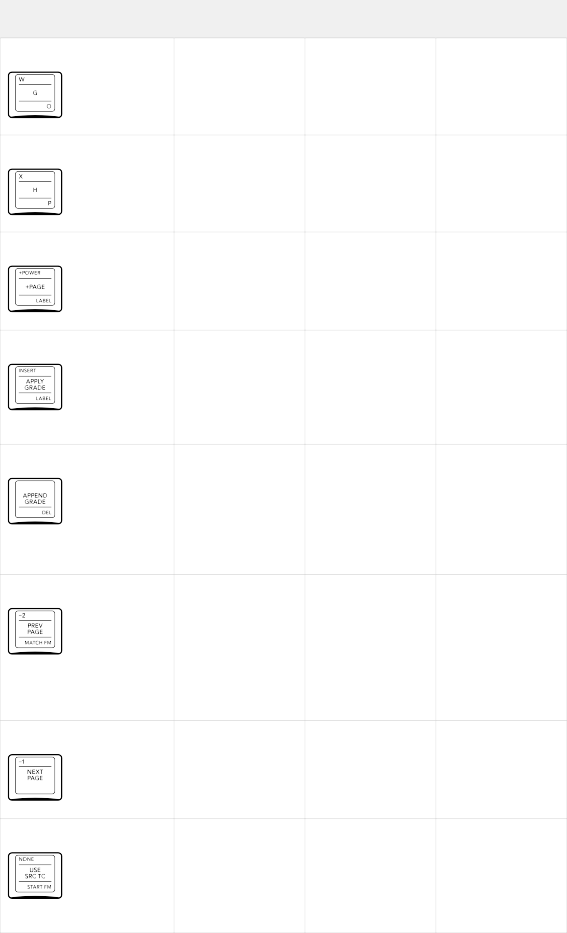

Key Shift Up Primary Function Shift Down
GROUP/RIPPLE SEL/APPEND (GROUP) Ripple Node
Changes to Group, when you select a clip that’s part of a group and make a change to one node, that change is rippled to the same node of every clip in the group
(RIPPLE SEL) Ripple
Node Changes to Selected Clips, when you select multiple clips and make a change to one node, that change is rippled to the same node of every selected clip
(APPEND) Append Node to Selected Clips, when you select multiple clips and make a change to a new node, that node is appended to the end of the grade of every selected clip
MISSING/GRAB STILL/ MIDDLE
(MISSING) Saves a still for every clip in the timeline that does not already have a still in the currently selected Album of the Gallery
(GRAB STILL)
Saves the currently displayed still in the Viewer, and
its grade, to the currently selected Album of the Gallery
(MIDDLE) Saves one still for every clip in the timeline at the middle of each clip
P/PONG/LOOP/PLAYHEAD (P/PONG) Toggles
looping mode between ping-pong and loop forward
(LOOP) Toggles playback looping on and off
(PLAYHEAD) Press
to add an Active Playhead to the Mini Timeline using the highlighted
the A/B/C/D keys above; once added, pressing PLAYHEAD and a letter switches playback control to that playhead
— Duration: To define a duration, first select the time using the numerical keypad (the colon separates the hours, minutes, seconds, and frames), and then select Duration.
— Cue: Selecting Cue will force the transport to the preroll position.
Management and Modes Group
![]()
This group of keys gives access to a wide variety of functions that, due to their diversity, are difficult to generalize. They include everything from the all-important Undo and Redo commands, to splitting and rejoining clips, setting and clearing In and Out points to control playback and looping, and commands for reverting to the Original Memory, using Preview Memory, and using Scroll (which is described in more detail later in this chapter).
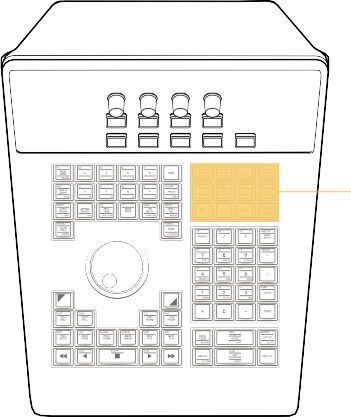
The Management and Modes Keys
The Management and Modes keys provide Undo/Redo, range,
![]()
Flag and Marker, printer lights, and grade management functionality.
Key | Shift Up | Primary Function | Shift Down |
SCENE/UNDO/ NEXT CLIP
| (SCENE) Opens the Scene Detect Window | (UNDO) Triggers one step of undo; DaVinci Resolve supports unlimited steps of undo | (NEXT CLIP) Not yet implemented at the time of this writing |
SPLIT/REDO/JOIN
| (SPLIT) Splits one clip into two at the frame under the playhead, so each split clip can be graded independently | (REDO) Triggers one step of redo; DaVinci Resolve supports unlimited steps of undo | ( JOIN) The reverse of the Split key; move the playhead to an edit point with contiguous timecode, and press JOIN to merge the clips into one. |
IN/CLEAR I
| – | (IN) Sets a timeline In point to use when looping playback | (CLEAR I) Clears the timeline In point |
Key | Shift Up | Primary Function | Shift Down |
DUR/OUT/CLEAR O
| (DUR) If you’ve set In and Out points, this key lets you create a marker with duration. | (OUT) Sets a timeline Out point to use when looping playback | (CLEAR O) Clears the timeline Out point |
SHOW/FLAG/CLIP
| (SHOW) Press to show a row of flag colors in the Trackball panel soft buttons with which to filter the Thumbnail Timeline by. < and > buttons let you page among all 16 colors, and EXIT lets you finish. Press SHOW ALL CLIPS in the soft menu to stop filtering. | (FLAG) Press to show a row of colors with which to flag the current clip in the Trackball panel soft buttons. < and > buttons let you page among all 16 colors, and EXIT lets you finish. | "(CLIP) Press to show a row of colors with which to color code the current clip in the Trackball panel soft buttons. |
SHOW/MARKER/NODE
| (SHOW) Press to show a row of marker colors in the Trackball panel soft buttons with which to filter the Thumbnail Timeline by. < and > buttons let you page among all 16 colors, and EXIT lets you finish. Press SHOW ALL CLIPS in the soft menu to stop filtering. | (MARKER) Press to show a row of colors with which to mark the current frame in the Trackball panel soft buttons. < and > buttons let you page among all 16 colors, and EXIT lets you finish. | (NODE) Press to show a row of colors with which to color code the current node in the Node Editor using the Trackball panel soft buttons. < and > buttons let you page among all 16 colors, and EXIT lets you finish. |
1/2/P/LITE/1/4
| (1/2) Sets printer points adjustments to be made in “half-point” increments | (P/LITE) Toggles “Printer Lights” on or off. When on, the Jog/Shuttle panel’s number keys are used to make printer point adjustments in “whole points” increments (shown on each number key’s “shift up” position). This key remains highlighted while P/LITE is on. | (1/4) Sets printer points adjustments to be made in “quarter-point” increments |
FLAG/DELETE/MARKER
| (FLAG) Deletes all flags on the current clip | (DELETE) Deletes the currently selected node in the Node Editor | (MARKER) Deletes any marker at the position of the playhead |
![]()
Key | Shift Up | Primary Function | Shift Down |
ORIG MEM
| – | (ORIG MEM) If you select a graded clip, then change the grade and decide you don’t like the change, press ORIG MEM to return to original state (or memory) of that clip when you first selected it. | – |
PVW MEM
| – | (PVW MEM) To preview how a saved memory looks when applied to the current clip, press PVW MEM and then any memory key. If you don’t like the result, press PVW MEM again to toggle the grade to how it was before. | – |
SCROLL
| – | (SCROLL) The Scroll key opens a row of controls on the Trackball panel soft buttons that lets you preview how grades on neighboring clips would look on the current clip, with the option to then copy a grade (EXIT AS IS) or cancel without doing anything (EXIT AS WAS). | – |
SAME/SELECT NODE/ LAST ADJ
| (SAME) Changes the “Switching Clips Selects” option to “Same Node” so that moving to another clip selects the same node in the Node Editor that was selected in the previous clip | (SELECT NODE) Press after typing a node number to change the currently selected node | (LAST ADJ) Changes the “Switching Clips Selects” option to “Last Adjusted Node” so that moving to another clip selects whichever node in the Node Editor was previously adjusted for that clip |
![]()
Jog/Shuttle Control
The Jog/Shuttle control is actually two controls in one. The Shuttle control is the outer knob, which rocks to the left and right and controls real-time or fast playback. The Jog control is an inner wheel that spins freely and controls the playhead in slow motion, a frame or two at a time.
— Shuttle: The Shuttle control is the outer knob, which rocks to the left and right. This knob has a detent at the center position which stops playback. Turning this control counter-clockwise shuttles among a variety of reverse speeds, with reverse playback going faster the farther left you turn. Turning this control clockwise shuttles among a variety of forward speeds, with playback going faster the farther right you turn.
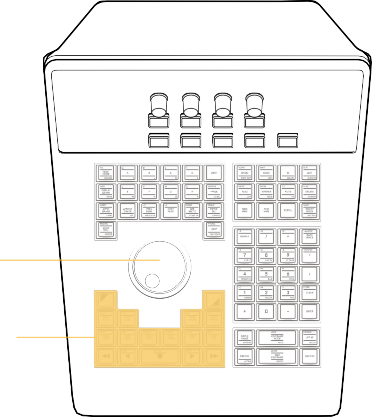
— Jog: The Jog control is an inner wheel that spins freely. Rotate the Jog control to step forward or backward a few frames at a time.
Jog/Shuttle Control
Transport Control Keys
![]()
The Jog/Shuttle control lets you control playback and playhead position. The Transport Control keys let you control playback, navigate stills in galleries, and navigate nodes in the Node Editor.
Transport Control Keys Group

SHIFT DOWN
SHIFT DOWN
SHIFT DOWN
–
–
–
(SHIFT DOWN) Enables use of any of the SHIFT DOWN key functions at the bottom of various keys
(SHIFT DOWN) Enables use of any of the SHIFT DOWN key functions at the bottom of various keys
(SHIFT DOWN) Enables use of any of the SHIFT DOWN key functions at the bottom of various keys
FLAG/PREV STILL
FLAG/PREV STILL
FLAG/PREV STILL
(FLAG) Go to previous flagged (PREV STILL) Selects the previous still; not yet implemented at the still in the currently selected time of this writing Album of the Gallery
(FLAG) Go to previous flagged (PREV STILL) Selects the previous still; not yet implemented at the still in the currently selected time of this writing Album of the Gallery
(FLAG) Go to previous flagged (PREV STILL) Selects the previous still; not yet implemented at the still in the currently selected time of this writing Album of the Gallery
FLAG/NEXT STILL
FLAG/NEXT STILL
FLAG/NEXT STILL
(FLAG) Go to next flagged still; (NEXT STILL) Selects the next still not yet implemented at the time in the currently selected Album of of this writing the Gallery, for use with the REF
ON or SPLIT SCREEN keys
(FLAG) Go to next flagged still; (NEXT STILL) Selects the next still not yet implemented at the time in the currently selected Album of of this writing the Gallery, for use with the REF
ON or SPLIT SCREEN keys
(FLAG) Go to next flagged still; (NEXT STILL) Selects the next still not yet implemented at the time in the currently selected Album of of this writing the Gallery, for use with the REF
ON or SPLIT SCREEN keys
CUE/FIRST FRAME
CUE/FIRST FRAME
CUE/FIRST FRAME
(CUE) Go to first frame of pre-roll; (FIRST FRAME) Selects the first not yet implemented at the time frame of the current clip
of this writing
(CUE) Go to first frame of pre-roll; (FIRST FRAME) Selects the first not yet implemented at the time frame of the current clip
of this writing
(CUE) Go to first frame of pre-roll; (FIRST FRAME) Selects the first not yet implemented at the time frame of the current clip
of this writing
CUE/LAST FRAME
CUE/LAST FRAME
CUE/LAST FRAME
(CUE) Go to last frame of pre-roll; (LAST FRAME) Selects the last not yet implemented at the time frame of the current clip
of this writing
(CUE) Go to last frame of pre-roll; (LAST FRAME) Selects the last not yet implemented at the time frame of the current clip
of this writing
(CUE) Go to last frame of pre-roll; (LAST FRAME) Selects the last not yet implemented at the time frame of the current clip
of this writing
FIRST/PREV NODE
FIRST/PREV NODE
FIRST/PREV NODE
(FIRST) Selects the first node in the Node Editor
(FIRST) Selects the first node in the Node Editor
(FIRST) Selects the first node in the Node Editor
(PREV NODE) Selects the previously numbered node in the Node Editor
(PREV NODE) Selects the previously numbered node in the Node Editor
(PREV NODE) Selects the previously numbered node in the Node Editor
LAST/NEXT NODE
LAST/NEXT NODE
LAST/NEXT NODE
(LAST) Selects the last node in the (NEXT NODE) Selects the next Node Editor numbered node in the Node
Editor
(LAST) Selects the last node in the (NEXT NODE) Selects the next Node Editor numbered node in the Node
Editor
(LAST) Selects the last node in the (NEXT NODE) Selects the next Node Editor numbered node in the Node
Editor
![]()
This group of keys is found beneath the Jog/Shuttle control. These keys are all about controlling playback and moving the playhead around your timeline.
Key | Shift Up | Primary Function |
SHIFT UP | – | (SHIFT UP) Enables use of any of the SHIFT UP key functions at the top of various keys |
Key | Shift Up | Primary Function |
MARKER/PREV FRAME
| (MARKER) Moves the playhead back to the last previous marker | (PREV FRAME) Moves the playhead backward a single frame in the Timeline |
MARKER/NEXT FRAME
| (MARKER) Moves the playhead forward to the next existing marker | (NEXT FRAME) Moves the playhead forward a single frame in the Timeline |
START/PREV CLIP
| (START) Moves the playhead to the first frame of the current clip | (PREV CLIP) Selects the first frame of the previous clip |
END/NEXT CLIP
| (END) Moves the playhead to the last frame of the current clip | (NEXT CLIP) Selects the first frame of the next clip |
FAST REVERSE
| – | (FAST REVERSE) Shuttles backward along the Timeline at fast speed; pressing multiple times increases speed. |
SLOW/REVERSE
| (SLOW) Plays in slow motion reverse (Edit page only) | (REVERSE) Plays the Clip/Timeline in reverse at 100%. |
REVIEW/STOP
| (REVIEW) Initiates Review playback; not yet implemented at the time of this writing | (STOP) Stops the current transport operation |
SLOW/FORWARD
| (SLOW) Plays in slow motion forward (Edit page only) | (FORWARD) Plays the Clip/ Timeline forward at 100% speed |
FAST FORWARD
| – | (FAST FORWARD) Shuttles forward along the Timeline at fast speed; pressing multiple times increases speed. |
![]()
Numeric Entry Group
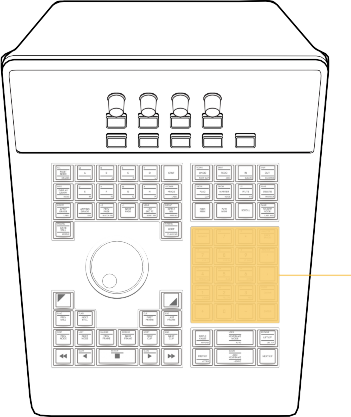
On the center right-hand side of the Search Dial panel is the Numerical Entry key group. Here you will find numbers 0 to 9 and associated keys for entering timecode and clip numbers. You will notice the numbers you type are displayed in a scratchpad area at the bottom of the Keyframe palette.
Numeric Entry Keys
![]()
The number keys group provides access to multiple overlapping functions, including Printer Points adjustment when the P/LITE mode is enabled.
Key | Shift Up | Primary Function | Shift Down |
+R/NUM LK
| +R (Plus Red in P/LITE mode) | (NUM LK) Locks these keys to their numeric functions, useful for entering timecode for navigation | – |
+G/ /
| +G (Plus Green in P/LITE mode) | (/) The Forward Slash key | – |
+B/ *
| +B (Plus Blue in P/LITE mode) | (*) The Asterisk key | – |
Key | Shift Up | Primary Function | Shift Down |
+MASTER/BACKSPACE
| +MASTER (Plus Master RGB in P/LITE mode) | (BACKSPACE) Moves the text or numeric cursor one character left so you can correct numeric entries | – |
–R/7/CHR LT
| –R (Minus Red in P/LITE mode) | (7) The seven key | (CHR LT) Loads the Chroma Light Qualifier preset |
–G/8/CHR DK
| –G (Minus Green in P/LITE mode) | (8) The eight key | (CHR DK) Loads the Chroma Dark Qualifier preset |
–B/9/LT DARK
| –B (Minus Blue in P/LITE mode) | (9) The nine key | (LT DARK) Loads the Chroma Light and Dark Qualifier preset |
–MASTER/ ‘
| –MASTER (Minus Master RGB in P/LITE mode) | (‘) The Apostrophe. When pressed by itself, copies the grade from one clip to the left to the current clip | – |
+C/4/MAGENTA
| +C (Plus Cyan or Green+Blue in P/LITE mode) | (4) The four key | (MAGENTA) Loads the Magenta Qualifier preset |
+M/5/BLUE
| +M (Plus Magenta or Red+Blue in P/LITE mode) | (5) The five key | (BLUE) Loads the Blue Qualifier preset |
+Y/6/CYAN
| +Y (Plus Yellow or Red+Green in P/LITE mode) | (6) The six key | (CYAN) Loads the Cyan Qualifier preset |
:
| – | (:) The Apostrophe key. When pressed by itself, copies the grade from two clips to the left to the current clip. When used after typing numbers, delineates timecode number positions (hr:min:sec:frm). | – |
![]()
Key | Shift Up | Primary Function | Shift Down |
–C/1/GREEN
| –C (Minus Cyan or Green+Blue in P/LITE mode) | (1) The one key | (GREEN) Loads the Green Qualifier preset |
–M/2/YELLOW
| –M (Minus Magenta or Red+Blue in P/LITE mode) | (2) The two key | (YELLOW) Loads the Yellow Qualifier preset |
–Y/3/RED
| –Y (Minus Yellow or Red+Green in P/LITE mode) | (3) The three key | (RED) Loads the Red Qualifier preset |
CLOSE/CLEAR
| (SHIFT UP CLOSE) | (CLEAR) Clears all numbers you were typing in case of mistakes | – |
+
| – | (+) The Plus key, use for entering relative timecode, such as +10 to move the playhead forward 10 frames | – |
0
| – | (0) The zero key | – |
–
| – | (–) The Minus key, use for entering relative timecode, such as –10 to move the playhead backward 10 frames | – |
ENTER
| – | (ENTER) The Enter key, use after you’ve typed a timecode value to execute moving the playhead | – |
![]()
Keyframing Group
The Keyframe keys are on the bottom right-hand side of the Search Dial panel. The functions are replicated on the T-bar panel. On the bottom right of the Color page is the Keyframe timeline for the current clip in the Timeline. The Keyframe group of keys is used in association with the Keyframe timeline and controls the selection of keyframes for the start and end of dynamic transitions of
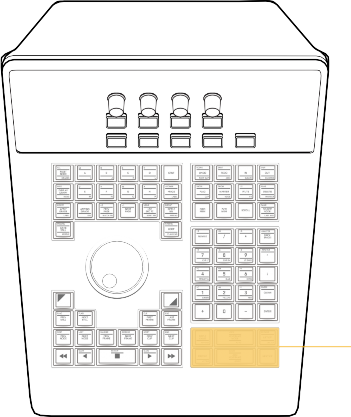
the grade.
Keyframing Keys
![]()
The number keys group provides access to multiple overlapping functions, including Printer Points adjustment when the P/LITE mode is enabled.
Key | Shift Up | Primary Function | Shift Down |
–/RIPPLE VALUE/ APPEND
| – | (RIPPLE VALUE) Lets you ripple a change made to the currently selected node to the same node within a specified range of clips; for more information see “Rippling Changes Using the Advanced Control Panel” later in this chapter | (APPEND) Lets you ripple a change made to the currently selected node as an appended node to a specified range of clips; for more information see “Rippling Changes Using the Advanced Control Panel” later in this chapter |
Key | Shift Up | Primary Function | Shift Down |
LOCK/KEYFRAME MODE/AUTO
| (LOCK) Locks the keyframe track of the currently selected node | (KEYFRAME MODE) Toggles among restricting keyframing to All (every keyframe track in a grade), Color (the currently selected Corrector node), or Sizing (sizing only). The Keyframe mode also determines which adjustments are copied when you copy grades from one clip to another. | (AUTO) Toggles Auto Keyframing on and off for the keyframe track of the currently selected node |
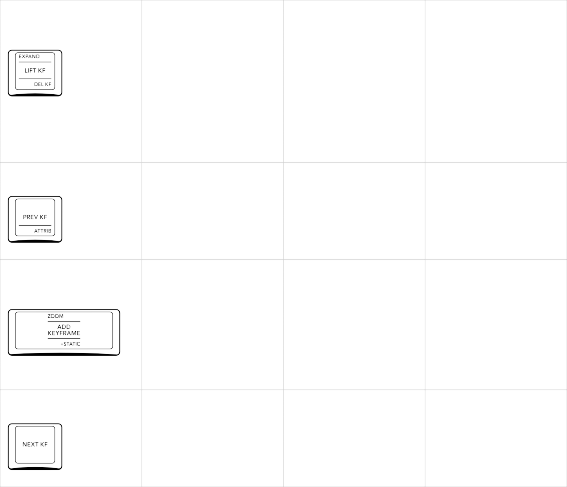
EXPAND/LIFT KF/ DEL KF
(EXPAND) Toggles the height of the Keyframe Editor while in Color
or Sizing modes to show or hide all internal Corrector node keyframing tracks. Doesn’t work in All mode.
(LIFT KF) Moves a keyframe to another location.
(DEL KF) Deletes
any and all keyframes at the playhead
–/PREV KF/ATTRIB – (PREV KF) Moves the
playhead to the next previous keyframe in the Node Editor
(ATTRIB) Opens the Dissolve Type window that lets you add easing to a selected keyframe
ZOOM/ADD
KEYFRAME/+STATIC
(ZOOM) Zooms into the Keyframe Editor; not yet implemented at the time of this writing
(ADD KEYFRAME) Adds
a dynamic keyframe to the currently selected corrector node, for creating a gradual animated change to a grade
(+STATIC) Adds a
static keyframe to
the currently selected corrector node, for creating an abrupt one- frame change to a grade
NEXT KF – (NEXT KF) Moves –
![]()
the playhead to the next keyframe in the Node Editor